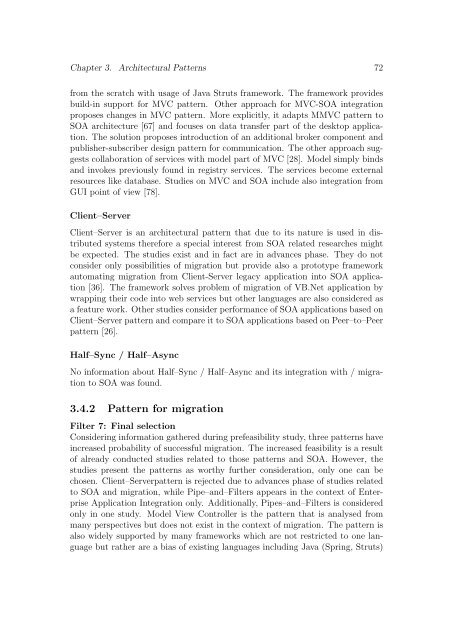Migration of a Chosen Architectural Pattern to Service Oriented ...
Migration of a Chosen Architectural Pattern to Service Oriented ...
Migration of a Chosen Architectural Pattern to Service Oriented ...
You also want an ePaper? Increase the reach of your titles
YUMPU automatically turns print PDFs into web optimized ePapers that Google loves.
Chapter 3. <strong>Architectural</strong> <strong>Pattern</strong>s 72from the scratch with usage <strong>of</strong> Java Struts framework. The framework providesbuild-in support for MVC pattern. Other approach for MVC-SOA integrationproposes changes in MVC pattern. More explicitly, it adapts MMVC pattern <strong>to</strong>SOA architecture [67] and focuses on data transfer part <strong>of</strong> the desk<strong>to</strong>p application.The solution proposes introduction <strong>of</strong> an additional broker component andpublisher-subscriber design pattern for communication. The other approach suggestscollaboration <strong>of</strong> services with model part <strong>of</strong> MVC [28]. Model simply bindsand invokes previously found in registry services. The services become externalresources like database. Studies on MVC and SOA include also integration fromGUI point <strong>of</strong> view [78].Client–ServerClient–Server is an architectural pattern that due <strong>to</strong> its nature is used in distributedsystems therefore a special interest from SOA related researches mightbe expected. The studies exist and in fact are in advances phase. They do notconsider only possibilities <strong>of</strong> migration but provide also a pro<strong>to</strong>type frameworkau<strong>to</strong>mating migration from Client-Server legacy application in<strong>to</strong> SOA application[36]. The framework solves problem <strong>of</strong> migration <strong>of</strong> VB.Net application bywrapping their code in<strong>to</strong> web services but other languages are also considered asa feature work. Other studies consider performance <strong>of</strong> SOA applications based onClient–Server pattern and compare it <strong>to</strong> SOA applications based on Peer–<strong>to</strong>–Peerpattern [26].Half–Sync / Half–AsyncNo information about Half–Sync / Half–Async and its integration with / migration<strong>to</strong> SOA was found.3.4.2 <strong>Pattern</strong> for migrationFilter 7: Final selectionConsidering information gathered during prefeasibility study, three patterns haveincreased probability <strong>of</strong> successful migration. The increased feasibility is a result<strong>of</strong> already conducted studies related <strong>to</strong> those patterns and SOA. However, thestudies present the patterns as worthy further consideration, only one can bechosen. Client–Serverpattern is rejected due <strong>to</strong> advances phase <strong>of</strong> studies related<strong>to</strong> SOA and migration, while Pipe–and–Filters appears in the context <strong>of</strong> EnterpriseApplication Integration only. Additionally, Pipes–and–Filters is consideredonly in one study. Model View Controller is the pattern that is analysed frommany perspectives but does not exist in the context <strong>of</strong> migration. The pattern isalso widely supported by many frameworks which are not restricted <strong>to</strong> one languagebut rather are a bias <strong>of</strong> existing languages including Java (Spring, Struts)
















